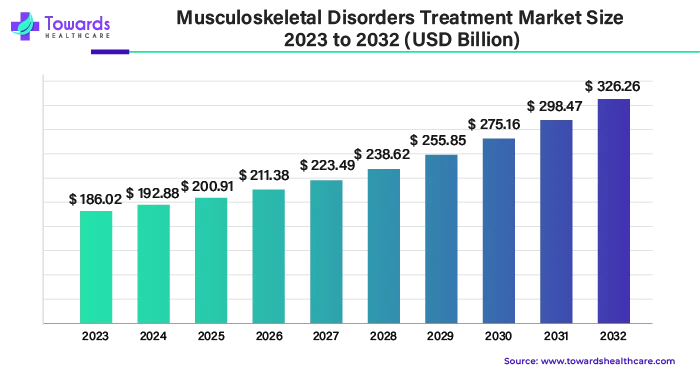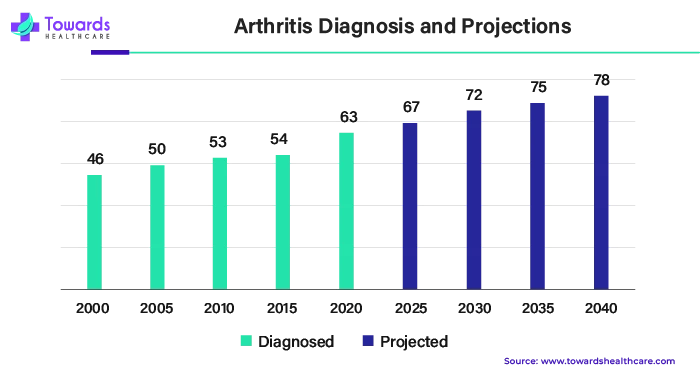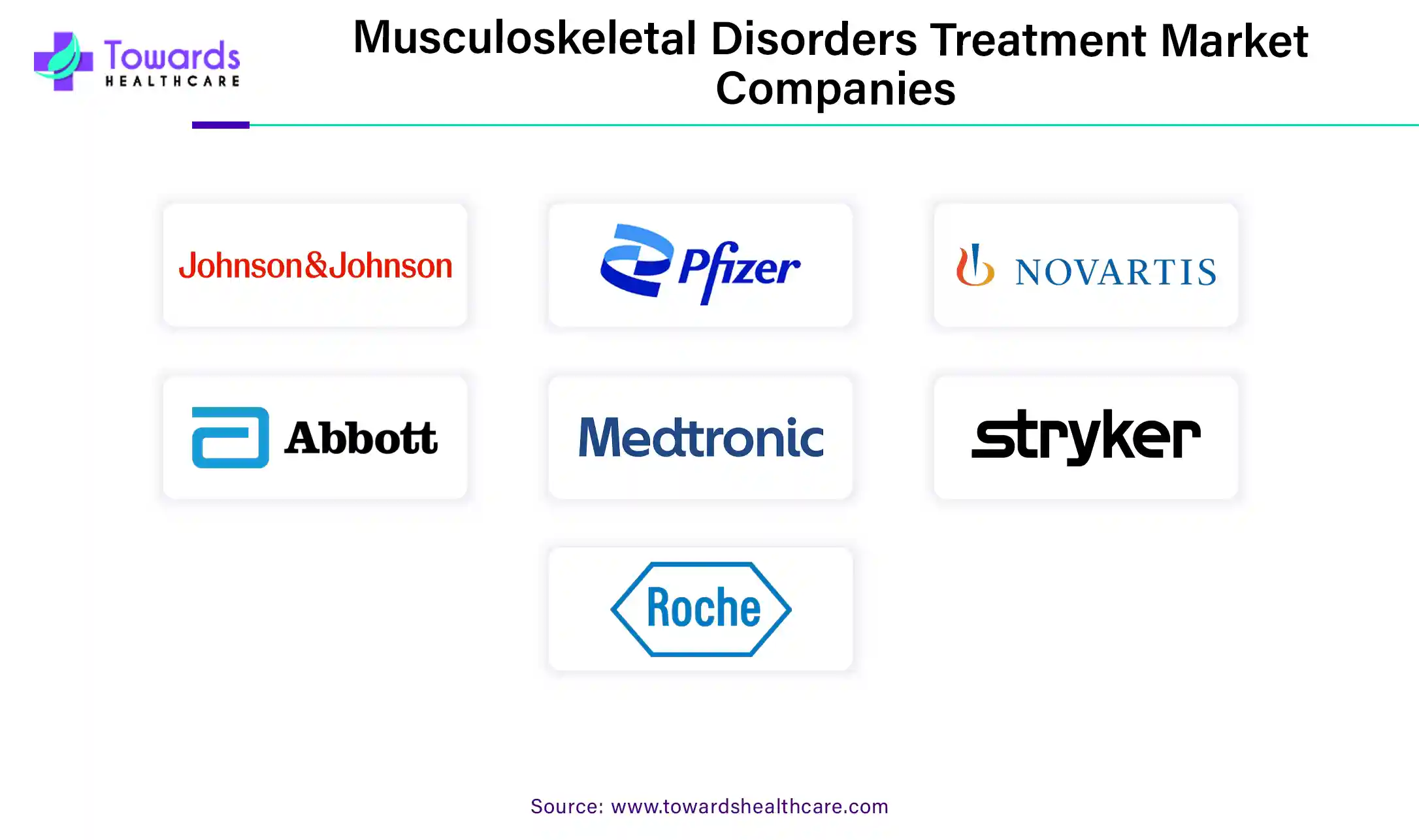April 2025

The musculoskeletal disorders treatment market is anticipated to grow from USD 209.01 billion in 2025 to USD 353.12 billion by 2034, with a compound annual growth rate (CAGR) of 6% during the forecast period from 2025 to 2034.

On 3 March 2024, Goa Medical College introduced India’s inaugural coated knee implants, projected to be priced under Rs.1 lakh, potentially around Rs. 80,000. The doctor highlighted its extended durability, with an expected lifespan of 30 years, surpassing the typical 15-20 years of regular implants that cost approximately Rs. 60,000 on average.
Musculoskeletal disorders are conditions that affect the muscles, bones, tendons, ligaments, and nerves in the body. These disorders can cause pain, stiffness, swelling, and limited movement in the affected area. Common examples include arthritis, tendonitis, carpal tunnel syndrome, and back pain.
Early diagnosis of musculoskeletal disorders is crucial for several reasons. It allows for prompt treatment, which can prevent the condition from worsening. Early intervention can also help alleviate symptoms and improve quality of life. Additionally, identifying musculoskeletal disorders early on can prevent further damage to the affected tissues and reduce the risk of long-term complications.
For instance,
Appropriate treatment for Musculoskeletal disorders depends on the specific condition and its severity.
For instance,
It may include a combination of medication, physical therapy, exercise, ergonomic modifications, and in some cases, surgery. Medications such as anti-inflammatories and pain relievers can help manage symptoms, while physical therapy can improve strength, flexibility, and function. Ergonomic modifications, such as adjusting workstations or using supportive devices, can also help alleviate strain on affected areas.
For instance,
Musculoskeletal disorders are disorders that affect the musculoskeletal system, causing pain and limited mobility. Early diagnosis is important because it allows for prompt treatment, which can prevent the condition from worsening and improve the quality of life. Appropriate treatment may include medication, physical therapy, exercise, and ergonomic modifications tailored to the individual's specific condition and needs.
Musculoskeletal disorders like arthritis, osteoporosis, and back pain are becoming more common worldwide. One big reason is that our population is aging. As people get older, their bones and joints can wear down, leading to conditions like arthritis and osteoporosis.
In 2021, the National Osteoporosis Foundation reported that among the 44 million Americans with weakened bones and nearly 10 million with osteoporosis, the risk of fracture elevated. Approximately 54 million individuals over 50 face a heightened risk of bone fractures, necessitating a focus on their bone health.

Another factor is our increasingly sedentary lifestyles. Many people spend a lot of time sitting at desks or on couches, which can weaken muscles and put strain on joints, leading to back pain and other musculoskeletal disorders. Obesity is also a big contributor. Carrying extra weight puts more pressure on our joints, especially those in the back, hips, and knees. This can increase the risk of developing arthritis and other musculoskeletal disorders.
Because more people are experiencing these problems, there's a greater demand for treatments and therapies to help manage the pain and improve mobility. This includes medications, physical therapy, and sometimes surgery. To address these rising needs, researchers and healthcare providers are constantly looking for new and better ways to treat musculoskeletal disorders. This might involve developing new drugs, improving surgical techniques, or finding innovative ways to deliver physical therapy.
As per the findings of the Arthritis Society, the report indicates that more than half (52%) of Canadians diagnosed with osteoarthritis are under the age of 65, nearly 4 million Canadians, equating to approximately one in seven adults, are affected by osteoarthritis. Due to this trend, there is an anticipated expansion in research investment within this field in the foreseeable future. As our population ages our lifestyles become more sedentary and obesity rates rise, the demand for treatments for musculoskeletal disorders continues to grow. This drives ongoing research and innovation in the field to improve the quality of life for those affected by these conditions.
Patients nowadays prefer treatments that don't involve cutting them open or causing too much disruption to their bodies. They like options that let them recover faster and with fewer problems. This trend is pushing doctors and scientists to come up with new ways to treat diseases and injuries without being too invasive.
Non-invasive treatments are those that don't require surgery or breaking the skin. They might include things like physical therapy, medications, or injections. Minimally invasive treatments are ones where doctors use small incisions or tools to perform procedures. Examples include laparoscopic surgery or arthroscopic procedures for joint problems. Patients like these approaches because they often mean less pain, shorter hospital stays, and quicker recoveries. They also tend to have fewer risks and complications compared to traditional surgeries.
To meet this demand, medical researchers are working on developing new techniques and devices that can achieve the same results as invasive procedures but with less disruption to the body. This could involve things like using advanced imaging technology to guide treatments more precisely or creating new types of medical devices that can perform procedures through smaller incisions. The shift towards non-invasive and minimally invasive treatments is driving a lot of innovation in healthcare, as doctors and scientists work to give patients the best possible options for managing their health conditions.
In the case of musculoskeletal health, governments run campaigns to raise awareness about conditions like arthritis or back pain. These campaigns teach people how to prevent these problems and where to get help if they have them.
Governments also provide money for research. This means scientists can study musculoskeletal disorders to find better ways to treat them. With funding, researchers can develop new medicines, therapies, or devices that make life easier for people with these conditions. Regulations are rules set by governments to ensure treatments are safe and effective. They make sure that new treatments meet certain standards before they can be used. This helps protect people from treatments that might not work or could cause harm.
Government support is vital because it helps make sure that everyone, regardless of their income or background, can get the help they need for musculoskeletal disorders. It also encourages innovation by providing resources for research and development. Government initiatives play a big role in shaping the market for musculoskeletal disorders by promoting awareness, funding research, and creating rules to ensure treatments are safe and accessible to all.
In simple terms, when we talk about joint replacement implants, we're referring to artificial parts that can be used to replace damaged or worn-out joints in the human body, such as knees or hips. These implants are often used to alleviate pain and improve mobility in people suffering from conditions like arthritis or injuries.
For instance,
When we mention the "Musculoskeletal Disorders Market," we're talking about the industry that deals with medical products and treatments for problems related to the muscles, bones, and joints. Now, the segment increase in this market means that there's a growing demand for joint replacement implants. This could be due to various factors like an ageing population, increased awareness about treatment options or advancements in medical technology making these implants more effective and accessible.
As more people face musculoskeletal issues, the demand for joint replacement procedures and implants has grown. This is because these implants can significantly improve the lives of those suffering from such problems. The technology behind these implants is always getting better, making surgeries more successful and enhancing how patients feel after the procedures.
Musculoskeletal disorder involves a variety of conditions affecting our bones, muscles, joints, ligaments, and tendons. The complexity arises because these disorders come in many forms, each with its unique challenges. Conditions like arthritis, osteoporosis, and back pain fall under this category. The difficulty in diagnosis stems from the fact that symptoms can be diverse and may overlap.
The treatment is truly intricate due to the personalized nature required for each disorder. What works for one person might not be suitable for another. Physicians must carefully customize treatments, considering factors like age, overall health, and specific musculoskeletal issues. Additionally, these disorders often require a multidisciplinary approach, involving orthopedic specialists, physiotherapists, and sometimes surgeons.
Furthermore, in medical complexities, the emotional and lifestyle impact on individuals with musculoskeletal disorders adds another layer of challenge. Chronic pain, mobility limitation, and the potential for long-term management create a comprehensive healthcare puzzle. Advances in research and technology aim to unravel those complexities, but a holistic understanding and personalized care remain crucial for effectively addressing musculoskeletal disorders.
The North American musculoskeletal disorder market is fiercely competitive, featuring a multitude of companies specializing in products and services for conditions like joint and bone disorders. Key players, including medical device manufacturers and pharmaceutical giants, actively compete for market share. Their focus lies in delivering effective treatments, medications, and pioneering solutions. This competitive landscape fosters a dynamic environment, compelling companies to constantly innovate in technologies and therapies. The ultimate goal is to enhance the quality of life for individuals grappling with musculoskeletal disorders, driving a continuous cycle of research, development, and advancement in the field.
Government in the Asia Pacific region plays a pivotal role in influencing the market through healthcare policies and regulations. Local and international collaborations contribute to knowledge exchange and advancement in musculoskeletal care. Additionally, the increasing prevalence of musculoskeletal disorders has heightened the demand for effective solutions, fostering competition among market players. Technological advancement, including the development of innovative medical devices.
The musculoskeletal disorder market involves companies that create products and services to address issues with muscles, bones, and joints. Key market players include pharmaceutical companies developing medications for pain relief and inflammation. Medical device companies create tools like braces, joint implants, and mobility aids. Physical therapy providers play a crucial role in rehabilitation. The market is competitive as companies strive to innovate with new treatments and technologies. Some focus on specific disorders like arthritis, while others offer comprehensive solutions. Research and development drive competition, with companies vying to create more effective and accessible treatments. Collaboration between pharmaceutical and medical device companies is common. Government regulations impact the market, ensuring safety and efficacy. The musculoskeletal disorder market is dynamic, with diverse players contributing to the well-being of individuals dealing with this health challenge.

By Type
By Product Type
By End User
By Geography
April 2025
April 2025
March 2025
March 2025